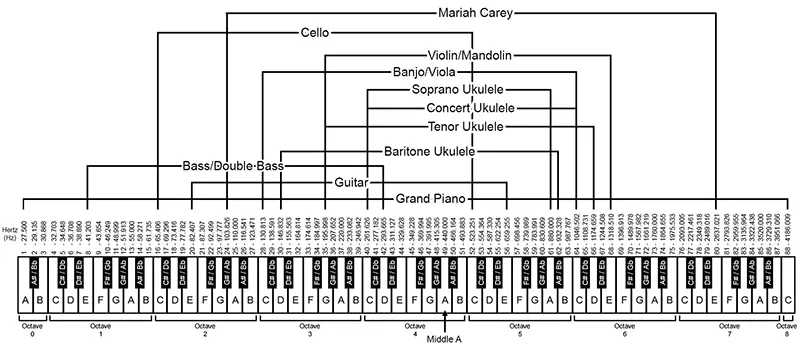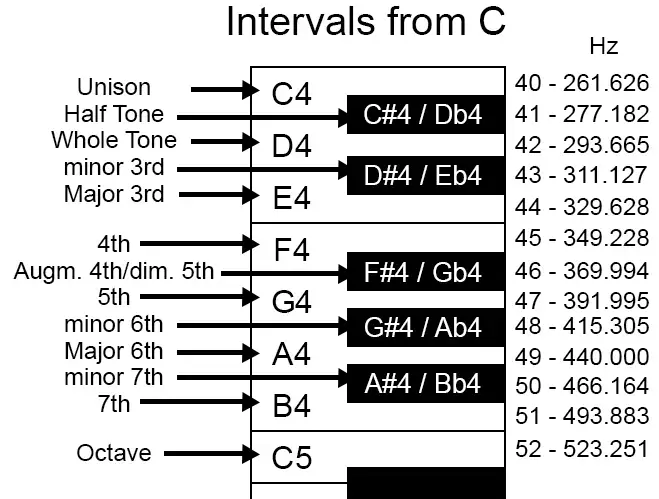What is pitch?
- Frequencies are measured by the number of cycles a sound wave makes per second or Hertz(Hz).
- Musical instruments are designed to produce dozens of fixed frequencies called pitches.
- These pitches are relative to each other which means that the difference of the pitches are mathematically set apart so that we as listeners can identify these frequencies and perceive it as music.
- Pitches are identified using 7 letters of the alphabet and 5 letters altered with a ‘#’ or a ‘♭’ symbol.
- The 7 notes are A, B, C, D, E, F and G.
- These 7 notes are known as natural notes.
- The 5 altered notes are A♭, B♭, D♭, E♭ and G♭.
- The ‘♭’ symbol is added to a note to flatten the pitch by a semitone or a half step below the natural note.
- The ‘#’ symbol means the note has been sharpened by a semitone or a half step above the natural note.
- The altered notes can also be written using the ‘#’ symbol.
- A♭ can be written as G#.
- B♭ can be written as A#.
- D♭ can be written as C#.
- E♭ can be written as D#.
- G♭ can be written as F#.
- Some natural notes can also be written using ‘#’ and ‘♭’.
- B can be written as C♭.
- C can be written as B#.
- E can be written as F♭.
- F can be written as E#.
Why a natural note will be written with a ‘♭’ or ‘#’ will make more sense in the lesson about scales.
What do pitches look like on a Piano?
- A grand piano is a musical instrument that generates the widest range of pitches than any other musical instrument.
- A grand piano can produce 88 musical pitches.
- The white piano keys are the natural notes.
- The black keys are the altered notes.
- The keyboard of a grand piano spans from octave 0 to octave 8.
- An octave can refer to a set of 12 pitches starting from one pitch and going up 12 semitones exactly doubling the pitch.

Frequencies of a Guitar, Bass, Ukuleles, Banjo, Mandolin, Violin, Viola and Double Bass compared to a that of grand piano.
Another thing to take note about the image above is the pattern of the frequencies produced by each note. Take a look at the first key on a piano which is the A0 key. When this key is played it produces a sound wave with the frequency of 27.5Hz. Now take a look at key number 13 which is A1. The A1 key is an octave above A0 and produces a frequency that cycles twice as fast as A0. If you play all of the A keys one after the other you will hear that frequency doubling in pitch. This applies to the rest of the keys on a piano. If you play any note on a piano and then play the note an octave above or below the frequency will double or cut in half.
What are Intervals?
Intervals is the distance each pitch is from one another. For instance, if you look at Middle C (C4) on a piano, the distance between C4 and C#4/Db4 is a semitone. The distance between C4 and D4 is a whole step also known as a Tone or 2 semitones apart. Intervals measure the distance from your starting point (Unison) in this case C4 and assign a role to the rest of the notes. If you start at C4 and go up 3 tones, or 6 semitones, you will land on the F#5/Gb5 key. Intervals tell us that the role of the F#5/Gb5 note to the C4 note is the diminished 5th. The image below shows the intervals of the rest of the notes relative to C4. If C is the unison the C#/Db is a semitone above, D is a tone above, D#/Eb is the minor 3rd, E is the Major 3rd, F is the 4th, F#/Gb is the augmented 4th or the diminished 5th, G is the 5th, G#/Ab is the minor 6th, A is the Major 6th, A#/Bb is the minor 7th and B is the 7th.

Intervals using the note C as the unison
The table below shows the role that each note plays according to the unison. This table will help you understand how the roles change when the Unison changes. A good exercise for beginners would be to play notes on a piano keeping in mind the role each note plays and use intervals to create emotion. With your left hand play single bass notes starting at the unison and using the right hand to play single notes navigating through the intervals ultimately making your way back to the unison.
| Unison | 1/2 Tone | Tone | min 3rd | Maj 3rd | 4th | dim 5th | 5th | min 6th | Maj 6th | min 7th | 7th |
|---|---|---|---|---|---|---|---|---|---|---|---|
| C | C#/Db | D | D#/Eb | E | F | F#/Gb | G | G#/Ab | A | A#/Bb | B |
| C#/Db | D | D#/Eb | E | F | F#/Gb | G | G#/Ab | A | A#/Bb | B | C |
| D | D#/Eb | E | F | F#/Gb | G | G#/Ab | A | A#/Bb | B | C | C#/Eb |
| D#/Eb | E | F | F#/Gb | G | G#/Ab | A | A#/Bb | B | C | C#/Eb | D |
| E | F | F#/Gb | G | G#/Ab | A | A#/Bb | B | C | C#/Eb | D | D#/Eb |
| F | F#/Gb | G | G#/Ab | A | A#/Bb | B | C | C#/Eb | D | D#/Eb | E |
| F#/Gb | G | G#/Ab | A | A#/Bb | B | C | C#/Eb | D | D#/Eb | E | F |
| G | G#/Ab | A | A#/Bb | B | C | C#/Eb | D | D#/Eb | E | F | F#/Gb |
| G#/Ab | A | A#/Bb | B | C | C#/Eb | D | D#/Eb | E | F | F#/Gb | G |
| A | A#/Bb | B | C | C#/Eb | D | D#/Eb | E | F | F#/Gb | G | G#/Ab |
| A#/Bb | B | C | C#/Eb | D | D#/Eb | E | F | F#/Gb | G | G#/Ab | A |
| B | C | C#/Eb | D | D#/Eb | E | F | F#/Gb | G | G#/Ab | A | A#/Bb |